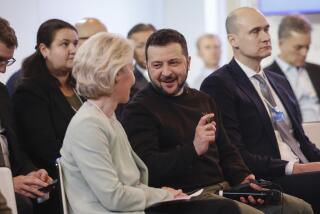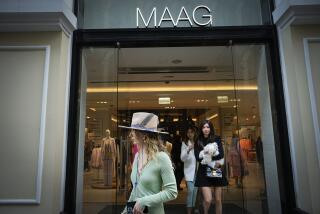Gorbachev Invites U.S. Firms to Settle In, Says ‘Opportunities Endless’
- Share via
MOSCOW — Appealing for help to pull the Soviet Union out of its deep economic crisis, President Mikhail S. Gorbachev on Tuesday promised American companies wide access to the Soviet market and a good return on their investment.
“If you get a foothold in the Soviet market, the opportunities will be endless,” Gorbachev said as he visited the first full-fledged U.S. trade show to be held in the Soviet Union. “Right now, we are rethinking everything, rearranging everything.”
Touring the exhibition, which includes IBM computers, Levi Strauss jeans, General Motors cars, Ritz crackers and Estee Lauder cosmetics, Gorbachev and Premier Nikolai I. Ryzhkov were more salesmen than prospective customers.
“Invest, do a deal, don’t be afraid--the profits are there,” the Soviet president told Daniel Compain, the representative of the Haddad Corp., a manufacturer of toys and children’s clothes. “Do you want to do just more than come and sell? If you are interested in joint manufacturing ventures, come and invest. The profits will be there, the profits will be there.”
For more than two hours, Gorbachev and Ryzhkov toured the exhibition and then talked further with senior U.S. executives in a determined pitch to boost Soviet-American trade above its desultory level of Soviet purchases of U.S. grain and American purchases of Soviet metals and mineral fertilizers.
“Provided you are not greedy and that you work openly with us, provided you just don’t want to come in, sell quick and then leave, your opportunities will be great here,” Gorbachev told Charles E. Hugel, the chief executive of Combustion Engineering Inc., which has developed a profitable, long-term relationship with the Soviet Union. “Patience pays.”
Nearly 150 U.S. companies, most of them industry leaders, are participating in the exhibition, which has been organized by the U.S.-U.S.S.R. Trade and Economic Council.
“The council’s primary goal is to demonstrate the range of U.S. export capabilities to the new Soviet decision makers,” William D. Forrester, the council president, said. “At the same time, we felt it important to reestablish strongly the presence of the U.S. business community in the Soviet market.”
More than 20,000 Soviet managers, engineers, technicians and specialists, as well as the general public, are expected to tour the exhibition during eight days.
And 1,000 senior executives of the U.S. companies have come to Moscow for what council officials anticipate will be some of the broadest and most intensive commercial negotiations that the two countries have ever held.
Moscow has frequently chided Washington for the failure of Soviet-American trade to match the overall improvement in their relations.
Despite a 75% jump last year, Soviet-American trade totaled only $3.4 billion, and if Moscow’s $2 billion in grain purchases were excluded that would be less than the trade between the United States and some countries with perhaps just 5% the population or wealth of the Soviet Union.
Dwayne O. Andreas, chief executive of Archer Daniels Midland Co. and the American co-chairman of the U.S.-U.S.S.R. Trade and Economic Council, said in opening the exhibition that President Bush had written him promising to press Congress to reduce tariff barriers for Soviet goods sold to the United States in an effort to expand overall trade.
Bush wrote that he was “prepared to work with Congress to open the way to extending most-favored-nation status” to the Soviet Union, Andreas told Gorbachev, reading from a letter from Bush. “It is time to begin to think anew. Positive changes are evolving in relations between our two countries.”
Gorbachev beamed at the unexpected news, which would represent an important diplomatic as well as economic breakthrough for Moscow.
In Washington, however, White House officials said the Administration’s position on trade concessions to the Soviet Union had not changed--Moscow must first put its recently liberalized emigration policy into new legislation before Bush will agree to lift the severe 15-year-old congressional restrictions on Soviet-American trade.
An immediate boost will come, however, from the import here of at least $500 million in consumer goods by six American companies that are negotiating a complex package of 20 or more joint ventures with Soviet partners. The consumer goods, greatly needed in a market that seems almost totally deprived of them, are intended as an advance payment by the American firms for their expected profits from the joint ventures.
Andreas, who announced the special import program, added that the six companies anticipate investing up to $10 billion in their joint ventures over the next decade.
The two developments will help fill the unsatisfied demand for quality consumer goods here and the need for investment capital to expand and modernize Soviet industry. Together, they will promote the overall reform program known as perestroika, Andreas said.
Gorbachev, while professing his optimism that “things will eventually straighten out,” acknowledged the depth of the current economic crisis, saying that Soviet industry is unable to meet the demand for goods.
“There is too much money chasing the goods we produce,” he said. “We did not pay sufficient attention to this development at the right time, and this has caused many uncontrolled problems, many uncertainties. So, consumers are hoarding now, and there are naturally shortages. For us today, the market is our No. 1 problem.”
More to Read
Inside the business of entertainment
The Wide Shot brings you news, analysis and insights on everything from streaming wars to production — and what it all means for the future.
You may occasionally receive promotional content from the Los Angeles Times.










